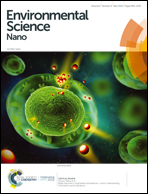The first comprehensive safety study of Magnéli phase titanium suboxides reveals no acute environmental hazard†
Abstract
Magnéli phase titanium suboxides (Magnéli TiOx) are novel conductive materials with great industrial potential. This is the first comprehensive investigation to provide an extensive dataset for hazard characterisation of Magnéli TiOx using six standardised test organisms and two human cell lines. Three Magnéli TiOx particles and three anatase crystalline phase TiO2 nanomaterials with different primary powder sizes, but similar hydrodynamic diameters in biological media, were investigated. All Magnéli TiOx and TiO2 nanomaterials induced negligible biological responses in Tetrahymena thermophila, Lemna minor, Artemia franciscana and Danio rerio. Adverse effects were found only at 100 mg L−1 where approximately 50% endpoint inhibition was recorded in the cases of Daphnia magna exposed to two Magnéli TiOx, Pseudokirchneriella subcapitata exposed to all three Magnéli TiOx and HepG2 cells exposed to one type of Magnéli TiOx. This study provides the first evidence that the tested Magnéli TiOx are not acutely hazardous according to existing EU classification for conventional chemicals.



 Please wait while we load your content...
Please wait while we load your content...